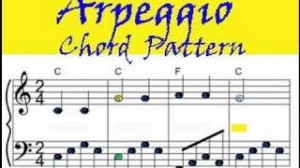Recommended
Categories
Improvisation
Lesson 17 - Chord Inversions |
|---|
I. Index1. Introduction II. Content1. IntroductionIn this lesson, you will learn how to make the transition between different chords in the left hand sound smoother. You can do this by playing the chords in different positions.2. Root Position ChordsYou have been playing most of the chords in the beginner section in root position. All this means is that when you played a C major chord, C was the first note in the chord. There are two more positions that a three note chord can be played in. One is the 1st inversion, and another is the 2nd inversion. Before we get to that, let's first look at the C major chord in root position.3. 1st Inversion ChordsLet's take a look at the C major chord in 1st inversion. To get the C major chord in 1st inversion, you just need to move the first note of the C major chord, which is C up one octave higher.4. 2nd Inversion ChordsLet's take a look at the C major chord in 2nd inversion. To get the C major chord in 2nd inversion, you just need to move both the first note and second note of the C major chord, which is C and E, up one octave.5. Playing a Song Using InversionsLet's first look at "Twinkle Twinkle Little Star" using only chords in root position. Notice how the chords seem to jump around.Let's now take a look at "Twinkle Twinkle Little Star" using chord inversions. You will be playing the C major chord in root position, so the order of the notes will be C, E, G. You will be playing the F major chord in 2nd inversion, so the order of the notes will be C, F, A. You will be playing the G major chord in 1st inversion, so the order of the notes will be B, D, G. It is easier to play once you get use to the different chord positions because you do not have to move your left hand around that much. Also, it sounds smoother because the notes are closer to each other when transitioning from one chord to the next. 6. ConclusionCongratulations, you have just played "Twinkle Twinkle Little Star" using inversions. Inversions can help chord progressions sound smoother. Try using inversions with other songs as well!
Custom Search
|
Recommended Stuff










